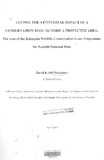| dc.description.abstract | This study was set up to look into socio-economic factors that influenced the success of the
Kitengela wildlife conservation lease program for Nairobi National Park. The specific objectives
were: (i) To establish whether the size of land owned by the respondents influenced their
willingness to join the lease Program (ii) To find out the socio-economic expectations of the
pastoralist landowners in the Kitengela area and suggest how wildlife conservation could help
meet some of them in a sustainable way (iii) Identify strategies that were socially, culturally and
economically acceptable to the landowners in mitigating the human-wildlife disharmony
prevalent in the dispersal area (iv) To outline the socio-economic and cultural factors likely to
influence the success of the lease program as a conservation tool in the dispersal area and suggest
areas of improvement and (v) To gauge the attitudinal impact of the Wildlife Conservation Lease
Program on the landowners.
A total of 100 household heads were interviewed usmg an interview schedule. 52 of the
respondents were on the Lease program while the rest (48) were not. Both groups were randomly
selected.
77% of the respondents were males while 23% were females. The average age of the respondents
was 47 years with the majority between the ages of 33-40 years. The average number of
dependants was 7.2. The majority attended primary school (47%) and secondary school (12.2%).
3.3% were in tertiary institutions. The average level of formal education was 4.5years with 42%
of the respondents having no formal education while 10% had over 12 years of formal education.
About 60% of the respondents practised semi-pastoralism as their main occupation while the rest
practised semi-pastoralism alongside trade and employment.
The average size of landholding was 150 acres and ranged between 4 -1,216 acres. The prices of
land ranged between KSh.50,000 and 600,000 and averaged KSh.188,400. Prices were directly
influenced by proximity to shopping centres, the tarmac road and the National Park. 50% of the
respondents lived within a range of 1-10 kilometres from the Park boundary (Empakasi River).
The average fenced area (for cultivation and grass reserves) was 10 acres.
The respondents lost 54% of their cattle during the year 2000 drought. However, by April 2003,
cattle numbers had built up by 44%. A significant proportion of the increase emanated from cattle
purchases. Emerging fences were cited as the main hindrance to cattle movement and grazing.
The numbers of three wildlife species namely: Eland, Wildebeest and the Coke's Hartebeest were
reported to have decreased, while those of four species namely: Ostrich, Gazelles, Hyenas and
Lions were reported to have increased.
94% of the respondents recommended the sharing of revenue and compensation for losses as the
best incentives for wildlife conservation outside the Protected Area. All those on the Lease
program were willing to remain on it and 94% of them cited school fees as the greatest benefit
they got from the program. 45.1% suggested that the lease contract duration be increased.
Ninety one percent of the respondents thought that killing of lions to show bravery was no longer
in practice and 82.7% felt that lions were only killed in retaliation for killed livestock. Attitudes
towards wildlife were found to be similar to those in the 1999 ACC survey (for those not on the
Lease program) but considerably different from those of people on the lease program, the latte
being in favour of wildlife. The conclusion was that the lease program had positively altered
landowners' attitudes towards wildlife.
The recommendations include the expansion of the lease program, strengthening of the
landowners Associations, supporting livestock keeping and eco-tourism activities, exploring
ways of benefit sharing with the Park, and addressing predation issues. | en |

